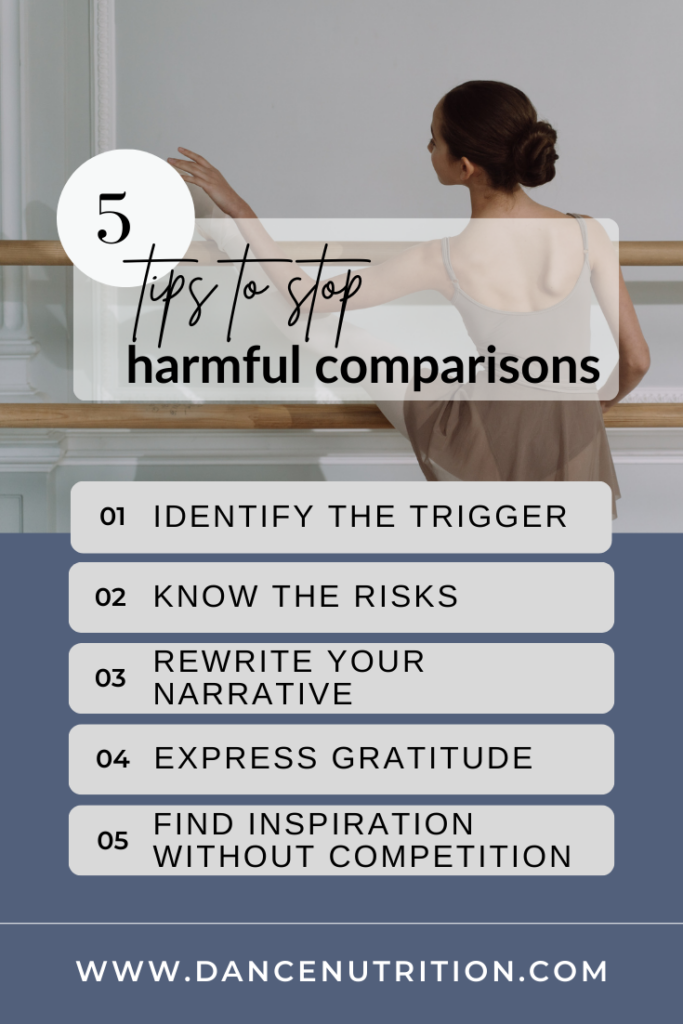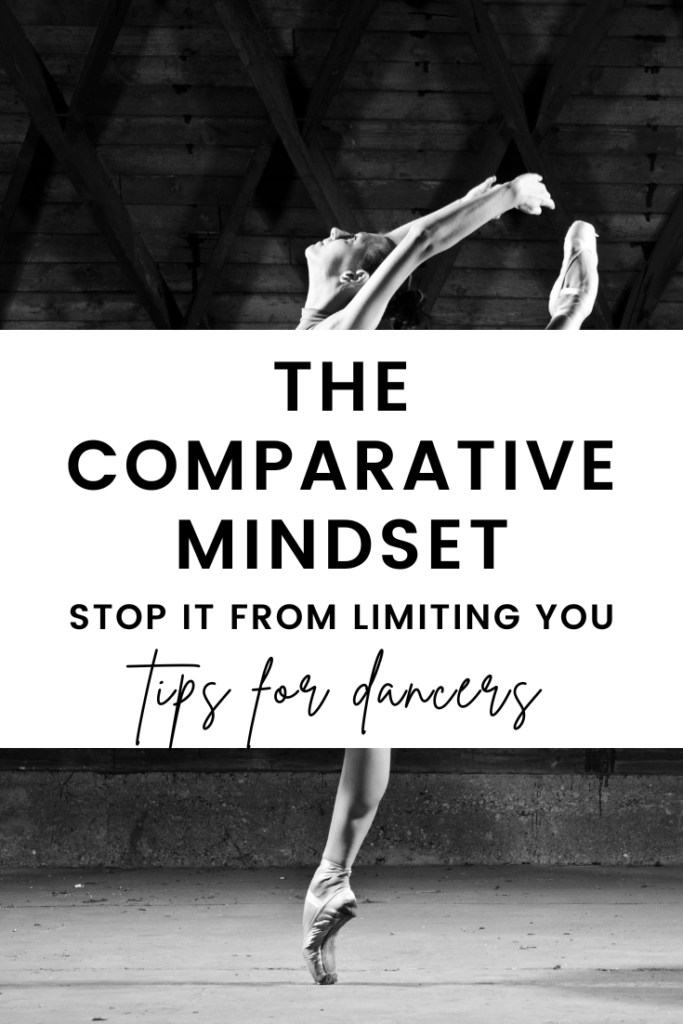Comparisons in the studio are, unfortunately, a common obstacle facing many dancers. Constantly comparing their bodies, skills, progress, and achievements to fellow dance peers— it can feel like an uphill battle for dancers to not compare themselves to others. The same goes for food comparisons. At mealtimes, many dancers find themselves second-guessing the amounts and types of food they include in their meal plans. With eating behaviors and body size often at the forefront of a dancer’s mind, it’s nearly impossible to not compare.
Whether in the studio or kitchen, the comparative mindset isn’t just detrimental to a dancer’s self-esteem, it can impede their creativity and overall performance potential. In this article, we explore why dancers are vulnerable to the comparative mindset, along with practical strategies to overcome it.
Why do dancers compare?
Looking at the dancer across the room might motivate us to work harder so, technically, isn’t it a good thing? Maybe. It’s human nature to compare ourselves to others. In fact, some believe that comparisons can drive growth. But for dancers who spend much of their time surrounded by like-minded individuals with similar goals, the comparative mindset can quickly spiral into unsupportive thoughts. Some of the most common reasons why dancers struggle with the comparative mindset include:
A tendency towards perfectionism
One of the main reasons dancers fall vulnerable to the comparative mindset is their pursuit of perfection. Precision and discipline are two hallmark characteristics of a dancer’s success— an undeniable pressure to outperform dance peers is often the reality of snagging a spot in a company or role in a performance. In this pursuit, dancers might find themselves constantly assessing their progress by comparing themselves to others.
Studio culture
For younger dancers partaking in dance competitions, rankings and scores often prevail. This intensifies the urge to compare performance achievements and ultimately, foster a belief that success is solely defined by winning. Dance competitions can easily overshadow a dancer’s artistic exploration and contribute to a dancer losing sight of their own unique artistic expression.
The realities of social media
While social media can be a powerful platform for inspiration, it can also trigger feelings of inadequacy and self-doubt. Scrolling exposes dancers to an endless stream of tricks, performances, tutorials, and supposed successes. A dancer’s social feed offers a front-row seat to the highlight reels of not just their peers, but also, renowned dancers worldwide. With an endless supply of content, it’s inevitable to compare our skills, bodies, and even food choices. What I Eat In A Day vlogs are notorious for encouraging the latter— here’s an article that uncovers the truths about these seemingly harmless posts.
How can dancers stop comparing themselves to others?
Whether at mealtimes or in the studio, the comparative mindset can be a significant obstacle facing a dancer’s pursuit of a professional career. By recognizing its roots and implementing strategies to productively navigate through comparisons, dancers can embrace their individuality and personal journey. Here are five steps to get you there:
Steps for dancers to overcome the comparative mindset
#1: Cultivate Self-Awareness
Acknowledge your feelings of comparison and self-doubt when they arise. Become aware of what you’re actually comparing. Is it a dancer’s skillset? Is it their body shape? Body proportions? Meals and snacks? A common comparison I hear among dancers is the assumption that a dancer exhibits a higher degree of “willpower” over certain foods (ie. Desserts).
At the moment of comparison, you’ll want to consider techniques to help regulate your thoughts and emotions. Mindful activities like meditation and deep breathing can help ground you in the present. Once there, recognize the importance of compassionate curiosity: it’s a natural human tendency to compare, but these comparisons are also not an accurate reflection of your worth as a dancer.
Step 2: Unlearn and fact-check
Consider the overall impact of your comparative thoughts as begin the active effort of fact-checking. Are you left feeling upset about your body? Body image plays a major role in your confidence both on stage and throughout life. Working towards a supportive body image can help.
Are you envious of one’s seemingly “healthy” eating behaviors? Remember, “willpower” is only a temporary form of control, and restrictive diets don’t work. In fact, even “clean” eating is a gateway into disordered eating. Here are a few helpful resources to continue the work of unlearning and fact-checking:
Step 3: Rebuild your narrative
Shift your focus from external comparisons to internal growth. This means setting realistic and attainable goals— those that emphasize progress rather than comparison. For example, if you envy the colorful veggies in your friend’s lunch, then consider how you can strive for colorful mealtime additions in a way that works for you. This might mean adding frozen veggies to a pre-packaged dinner or, ironically, skipping the veggies until a time when they’re more accessible. There’s absolutely no judgment in your choice and decision.
When working with dancers, I recommend that they start journaling as an opportunity for self-reflection and self-discovery. Here are 4 journaling exercises to start rewriting your narrative:
- Why am I giving [insert comparative thought] so much weight?
- If thinking “I wish my [insert whatever you’re envious of here] was like that,” then start thinking “This dancer’s [insert whatever you’re envious of here] is [insert descriptive adjective here], but what I see might not reflect this dancer’s full story.” Realize that individuals are unique beings and what you might notice on the outside isn’t always reflective of a dancer’s entire story.
- If your envy spews from social media, it may be time for a break. Remember: social media allows us to create a curated highlight reel. In other words, we can never know someone’s life by just looking at pictures or videos.
Step 4: Embrace your individuality
It’s easy to focus on minuscule events like casting lists and roles. But your style, strengths, and weaknesses contribute to your personal artistic identity, making you stand out in your own way. As discussed previously, journaling can help to build confidence through self-reflection. Here’s an example: List your most common comparative thoughts and then, brainstorm 5 experiences and/or personal characteristics that you are currently grateful for. Neutral affirmations can help.
Step 5: Turn comparisons into inspiration
As a recovering perfectionist, I know how consuming the comparative mindset can be. In my recovery from all-or-nothing thinking, I’ve learned to approach comparisons with empathy and replace them with inspiration. How might another dancer’s behavior (assuming it’s a supportive one) inspire you? It will be important to surround yourself with like-minded dancers who foster supportive relationships with both their bodies and food choices.
Engage in open conversations about the comparative mindset, encouraging each other to work together, rather than against each other. Self-confidence is again your best tool for doing this. Trusting your journey, making space for these challenges, and opening doors to supporting others is encouraged.




